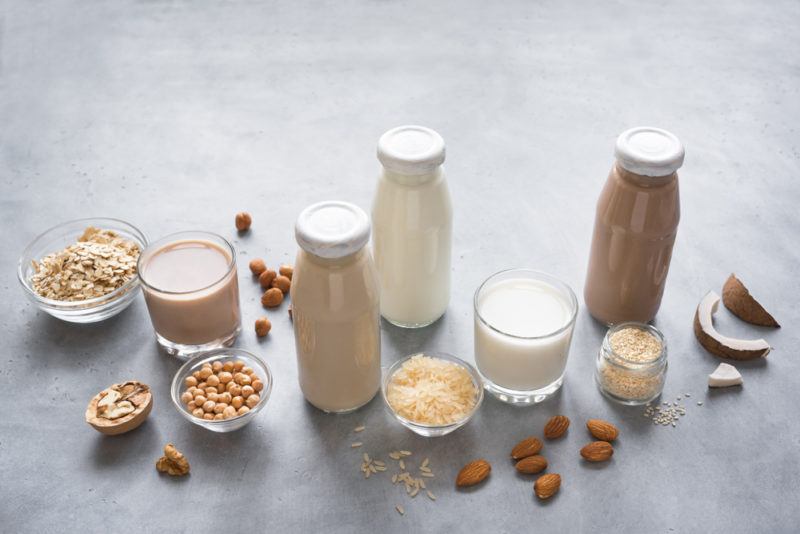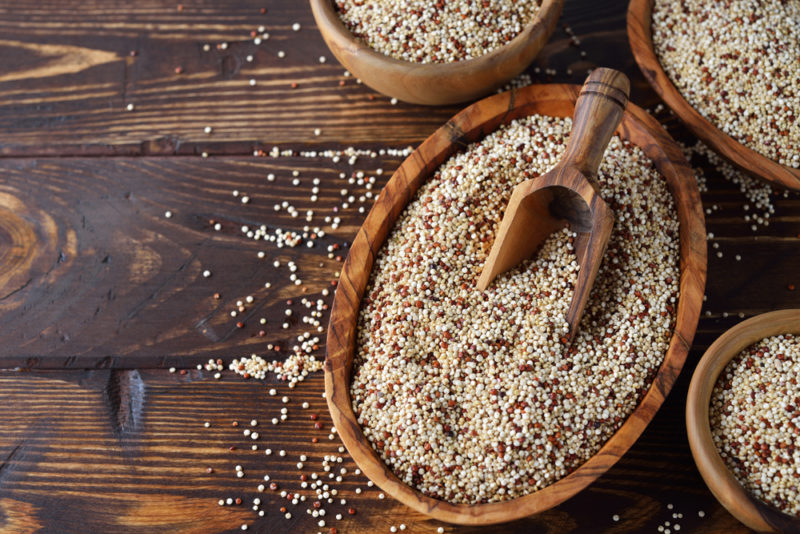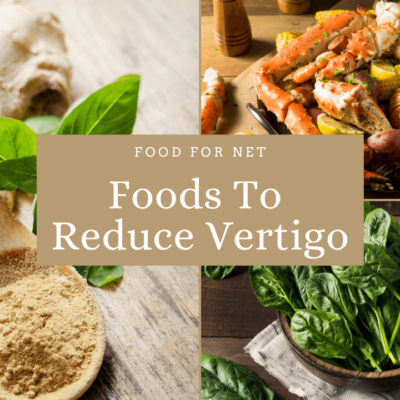
Fibromyalgia is a frustrating condition that can cause widespread pain throughout your body, along with sleep problems, fatigue, and mood issues. There is no known cure for the condition, nor is it well-understood. However, choosing good food for fibromyalgia may help to decrease your symptoms or prevent things from getting worse.
While there isn’t a specific fibromyalgia diet, we do know that food has many different effects on our physical and mental well-being. Good food choices can help us to feel more energized and less stressed, making the day feel much easier than it would be otherwise. On the other hand, poor choices can make us feel lethargic or even nauseous.
The foods featured in this list may help fibromyalgia in various ways. Some help to decrease inflammation, often by providing you with powerful plant-based compounds. Others are good alternatives to foods that might trigger food sensitivities. For example, consuming lactose when you’re lactose intolerant could easily make your fibromyalgia symptoms seem much worse.
It’s also important to experiment with your food.
Fibromyalgia is a varied condition. It affects people differently and the effects of food can be just as individual. Plus, fibromyalgia can co-occur with other conditions, which varies responses even more.
It can help to keep a diary of the foods you eat and your fibromyalgia symptoms. This way, you can easily see when your pain is the most significant. This should help you to identify the foods that are making your symptoms worse and the ones that are making you feel better.
Best Foods For Fibromyalgia
- Lactose Free Dairy
- Low Fat Dairy
- Plant-Based Milks
- Whole Grains
- Pseudocereals
- Dark Leafy Greens
- Vegetables
- Frozen Vegetables
- Fresh Fruit
- Herbs And Spices
- Nuts
- Seeds
- Eggs
- Fish
- Chicken And Turkey
- Olive Oil
- Whole Foods
- Legumes
- Gluten Free Products
Lactose Free Dairy

Lactose intolerance is a common condition that often develops slowly during a person’s life. It occurs because your body isn’t producing enough of the enzyme lactase, which breaks down the lactose in dairy products.
If you’re lactose intolerant, then you’ll experience gastrointestinal symptoms within an hour or two after eating dairy. This can include feeling bloated, experiencing significant flatulence, and nausea.
Having fibromyalgia doesn’t mean that you’re also lactose intolerant, but the two conditions do often co-occur. And, eating lactose when you’re intolerant may also increase the symptoms of fibromyalgia.
Lactose free dairy products are an easy way to keep your nutrient intake up while avoiding lactose. These products are still made from milk, but the enzyme lactase is used to break down the lactose. This means that your body doesn’t need to do the hard work.
Products like lactose free milk, lactose free sour cream, and lactose free cream cheese are very similar to their lactose-containing counterparts. This makes them easy to use as a replacement to regular versions.
Low Fat Dairy

Many people find that they don’t need to cut out dairy entirely, but they do get benefits from focusing on low fat versions instead. Low fat dairy tends to contain less saturated fat and fewer calories than full fat dairy, while still providing many other important nutrients.
This is an area that you will need to experiment with for yourself, as there is still a lot of controversy surrounding dairy and saturated fat, including the idea that dairy contributes to inflammation and that saturated fat increases heart disease risk.
There’s mixed evidence for both of these claims. For example, some research suggests that saturated fat doesn’t increase heart disease risk, but we still don’t know the full impacts of large amounts of saturated fat over a lifetime.
Plant-Based Milks

Even if you can digest lactose, you might choose to avoid dairy entirely. There are many reasons for this, including the fact that dairy is thought to cause inflammation, which we mentioned before.
The link between dairy and inflammation is highly debated. Some research suggests that dairy may be inflammatory, while other research fails to find that effect at all. There’s even the chance that dairy might decrease inflammation, just to make things more confusing.
Still, if you’re worried about dairy and inflammation, cutting it out is certainly an option. The nutrients in dairy can all be found elsewhere, so you’re not missing out, as long as you maintain a healthy diet.
Plant-based milks are good place to begin cutting back on dairy. There are plenty of these to choose from, like soy milk, almond milk, and coconut milk. Some will even be fortified with protein or calcium, to give you a similar nutrient balance to dairy milk.
We’re not just talking about drinking this type of milk alternative either. You can also use plant-based milks in many meals. Each type of milk has its own quirks, so you’ll probably need to follow a recipe to begin with.
Whole Grains

Whole grain foods are important for health in many ways. They offer a wide variety of nutrients and help you to keep your fiber intake high too. This is one reason why whole grain bread and brown rice is often recommended over their white counterparts.
Eating whole grains on their own is beneficial too – and we’re not just talking about wheat and rice here. For example, oats are also considered a whole grain. Oats are particularly important too, as the soluble fiber they contain offers many health benefits.
Pseudocereals

You can also turn to pseudocereals, like quinoa and buckwheat. While these aren’t technically grains, they do have a similar nutritional profile. Some of them, like quinoa, even offer more nutrition than most whole grains.
Plus, pseudocereals tend to be gluten free. This is important for anyone who is gluten intolerant. While gluten doesn’t appear to cause fibromyalgia, eating gluten regularly may make the symptoms of fibromyalgia worse.
For that matter, research suggests that a gluten free diet can improve fibromyalgia symptoms, even for people who do not have celiac disease. More studies need to be done to confirm those claims, but if you have significant fibromyalgia pain, cutting down on gluten is certainly worth trying.
Dark Leafy Greens

Dark leafy greens, like kale and spinach, are well-known for being rich in nutrients, including vitamin C, vitamin A, calcium, potassium, and iron. There are many important plant-based compounds present too, including antioxidants.
The balance of nutrients changes from one type of leafy green to another. For example, kale contains much more calcium than spinach does.
While kale is often called the healthiest dark leafy green, the best approach is to rely on many different options. This way you’re getting a wide variety of nutrients in your diet. Doing so is especially important when you have fibromyalgia.
Vegetables

Eating well involves relying on vegetables. There’s no way around that. Once again, there’s no single best type to choose. Instead, you should aim to include many different vegetables in your diet.
Try to focus on different colors. The colors of fruits and vegetables come from pigment molecules, which can have different effects on your health.
And also, look for vegetables that you enjoy. So, if you don’t like kale – don’t eat it. You can get similar benefits from other dark leafy greens. Taking this approach to vegetables makes it much easier to get the nutrients that you need. Besides, with so many vegetables out there to choose from, you’re certain to find some that you love.
Frozen Vegetables

When we think about healthy food, most of us focus on fresh foods. And yes, you will get more nutrients from a freshly picked vegetable from your garden, but that doesn’t mean that fresh is your only option.
Frozen vegetables are much healthier than most people assume. They’re typically snap frozen at the point of harvesting, right when they are the best for you.
The freezing process does affect the quality of the vegetables and can decrease antioxidant concentration and other important things. But, then again, so does time. By the time vegetables get from the grower to the grocery store to your home, they have deteriorated somewhat.
In the end, frozen vegetables are often just as healthy as anything that you buy fresh from your local store. They’re also much more convenient. Using frozen vegetables is a great way to still eat well, even when your fibromyalgia symptoms are severe and you’re limited in the tasks that you can do.
However, you’ll need to look out for products that just contain vegetables. Avoid any that involve additives, as these can sometimes trigger fibromyalgia symptoms (and aren’t good for you anyway).
Fresh Fruit

Fruits have a mixed reputation. They’re a source of many important compounds, including antioxidants, polyphenols, and fiber.
On the other hand, they’re high in sugar. Sugar contributes to inflammation, which could make fibromyalgia symptoms worse. Even if you’re not sensitive to sugar, it can lead to weight gain if you consume too much.
Fruit is healthier than most other sources of sugar, especially as there is plenty of fiber present. A diet rich in fruits and vegetables is even linked to decreased inflammation.
Whenever possible, focus on whole fruits, rather than options like fruit juice. Even including fruit in smoothies can be problematic, as it’s easy to eat more fruit than you intend to.
Herbs And Spices

Herbs and spices are essential if you cook your own food, as herbs and spices provide much of the flavor. Relying on herbs and spices also helps you to avoid relying on sauces and premade mixes from the store. Such products often contain additives, while herbs and spices don’t.
That’s not all. Herbs and spices tend to be concentrated source of polyphenols from plants. This gives them the chance to improve your health in many ways.
Some herbs and spices may be particularly beneficial, as they can help to reduce inflammation in your body. Cloves, ginger, rosemary, and turmeric top the list. Cinnamon may be important too.
You don’t need to supplement with large doses of these herbs and spices. Even everyday amounts can offer benefits, especially if you’re using them regularly. Don’t just stick to a few favorites either. Each herb and spice has its own unique balance of compounds, so variety is your friend.
Nuts

Nuts are another important whole food ingredient. They’re a rich source of protein and nutrients, while also offering healthy fats. The protein content makes them satisfying as snacks. Plus, nuts don’t tend to contribute to inflammation, so they’re a good choice.
Nuts are easy to enjoy too. You can simply grab a handful as a snack or scatter them on a meal. Nut butter gives you a more concentrated source of nutrients from nuts.
Most types of nuts will be perfect, but you may want to steer clear of peanuts and peanut butter. Peanuts are technically a legume rather than a tree nut – and some people feel that legumes may have negative impacts on health.
If nothing else, there’s a chance that peanuts increase inflammation. This may be reason enough to avoid peanuts. After all, there’s no shortage of other nuts to choose instead.
Seeds

Seeds of all types are another whole food choice that can be just what you need if you have fibromyalgia. Like nuts, they contain no shortage of nutrients and are very easy to use. You could even try making a trail mix that contains various nuts and seeds.
If you’re focused on snacking, then pumpkin seeds and sunflower seeds are good choices. These are relatively large seeds, which makes them easy to pick up and eat. Plus, they’re often found roasted.
Chia seeds are popular too. These seeds are tiny and they don’t have much flavor. This lack of flavor isn’t a bad thing – it is the reason that it’s so easy to add chia seeds on top of almost any meal. The seeds are interesting, as they become gelatinous when soaked in water, so you can use them to make chia seed puddings or a chia egg.
Chia seeds and flax seeds both contain plant-based omega-3 fatty acids, which is another reason for featuring them in your eating plan.
Eggs

Eggs are such an interesting ingredient. We rely on them heavily, especially for breakfasts. They’re fantastic as a source of protein and contain many other nutrients too.
Yet, there’s been no end of controversy surrounding eggs. Some people call them unhealthy, due to their high cholesterol content. Others say that eggs are healthy, especially as the cholesterol in our diet isn’t the only thing that controls the cholesterol in our blood.
Current evidence suggests that eggs are healthy, as long as we’re not eating a large number of them each day. This is fantastic news, as eggs can be an easy way to improve nutrient intake.
Eggs are extremely relevant for fibromyalgia sufferers because they contain vitamin D. There may be a link between low vitamin D levels and fibromyalgia for some people. Even if this isn’t the case for you, vitamin D may help in other ways, such as improving your bone health.
Fish

Fish is almost essential as part of a healthy diet. Fish is the best way to get omega-3 fatty acids. These fatty acids have been linked to many health benefits, including decreased inflammation.
Fish also tends to be low in fat and high in protein. This balance is powerful for many situations. And, of course, there are many beneficial nutrients in fish too.
However, you do also need to be careful. Fish contains mercury, which is often in the form of methylmercury. This mercury is easily taken up into our bodies and is a serious health hazard. Pregnant women need to be especially aware of their mercury intake, although all people should be careful not to consume too much mercury.
Some good choices of fish include salmon, cod, tilapia, and flounder, all of which are relatively low in mercury. You can also turn to sardines. These little fish have even less mercury, as they feed on plankton.
Other fish have more mercury and you may need to be careful about your intake. Canned tuna is an especially concerning type, which can increase your mercury intake quickly. Eating canned tuna occasionally may still provide health benefits, but try not to have more than one serving per week.
Chicken And Turkey

Chicken and turkey are both lean sources of protein. They contain essential amino acids too, which play key roles in many systems in our bodies.
The leanness of chicken and turkey may be important too, as some experts feel that fatty meat contributes to health problems. Chicken and turkey are also important alternatives to red meat – as the effects of red meat on health are heavily debated.
While red meat does contain nutrients that you need, including plenty of iron and vitamin B12, high levels of consumption have been linked to health problems, like increased cancer risk and heart disease. It’s not entirely clear what levels of red meat consumption are healthy, but experts often suggest that people consume more red meat than they should be.
Besides, chicken and turkey are both delicious, they can be used in many meals, and are easy to find in your local store. With all these advantages, chicken and turkey are simply too good to ignore.
Olive Oil

Olive oil is thought to be one of the healthiest oils out there. It’s easy to see why too, as the oil contains a large number of important polyphenols. Olive oil is also a source of monounsaturated fats. This type of fat may provide a variety of health benefits – especially if you replace saturated fats in your diet with monounsaturated ones.
Finding a good product is important when you’re using olive oil.
There have been many problems with counterfeit products, such as bottles that are marketed as extra virgin olive oil, but actually contain a different type of olive oil. Some olive oils have even been adulterated with other types of oil to save the company money.
There aren’t many tests out there to work out whether extra virgin olive oil is genuine or not, so finding a reliable brand is critical. Thankfully, you can turn to the internet for assistance and there are many useful reviews out there that can guide you.
Whole Foods

You may have noticed a pattern with the foods on this list. They’re mostly natural choices, ones that you may need to cook or prepare yourself before eating them.
This is a critical approach if you want to be healthy. Society has got into the habit of relying on processed foods, including meals that you can simply heat up or products that can be eaten straight out of the packet.
The problem is that processed foods often include additives that can be detrimental to health. Many of these may trigger symptoms in people with fibromyalgia. Monosodium glutamate (MSG) and nitrates are two examples of additives that you should avoid.
In practice, something that you make yourself will almost always be healthier than something heavily processed that you buy from the store.
Legumes

Legumes include foods like beans, chickpeas, soybeans, and lentils. Legumes are all highly nutritious. They’re especially popular as vegetarian sources of protein and are also inexpensive ways to bulk meals out and make them more interesting.
It’s easy to see why legumes are often recommended for health. They also feature in many healthy diets, including Mediterranean eating plans.
Many fibromyalgia sufferers do eat legumes for these reasons and experience no problems with them. Still, legumes are controversial. They contain significant amounts of phytic acid and lectins, both of which could influence nutrient absorption. Research suggests that the benefits of legumes far outweighs any potential issues, especially if you soak them first.
As always, the best approach is to experiment for yourself. Pay attention to how your body responds to different legumes. This will give you the best indication of whether to include them in your diet.
Gluten Free Products

While gluten doesn’t cause fibromyalgia symptoms, many fibromyalgia sufferers find that they do better when they cut gluten out of their diet. This isn’t too surprising, as fibromyalgia and gluten sensitivity can co-occur. And, if you’re eating gluten when you’re sensitive to it, the gluten could easily contribute to inflammation or give you some side effects.
A simple step is to remove gluten from your diet for a while and then re-introduce it. Doing this can help you to see what effect gluten is having. You may be perfectly fine with it or you may find that you do better skipping gluten entirely.
If you are going the gluten free route, it’s important to choose your foods carefully.
Many gluten free products are heavily processed and contain additives that might make your fibromyalgia symptoms worse. Some of these products end up being high in sugar or have ingredients that quickly convert to sugar.
Heavily processed gluten free foods, particularly those with additives, are often worse for you than whole foods that contain gluten.











 The World’s Best Coffee Growing Regions & Their Flavor Profiles
The World’s Best Coffee Growing Regions & Their Flavor Profiles
Leave a Reply